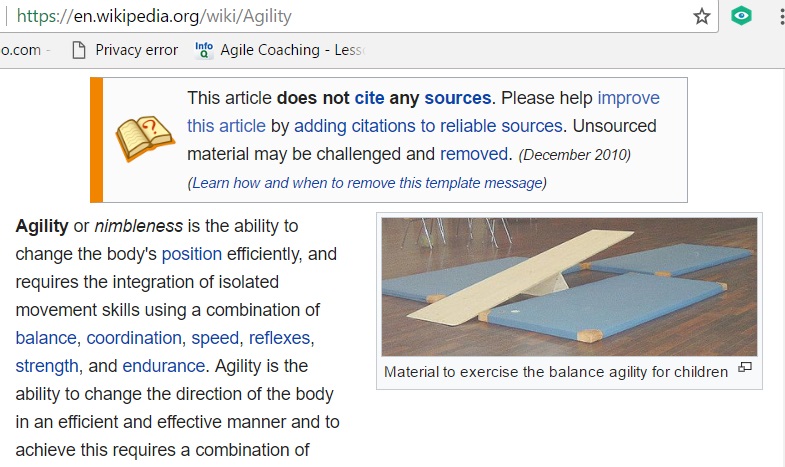These days, almost everyone knows that organizations cannot “do” agile; they can “be” agile. And today, this contrast is used not just by agile coaches and scrum masters. Everyone likes building this fancy figure of speech in their daily lexicon: managers, analysts, developers. Great!!! Below is a snippet from Wikipedia, defining the word “agility“, using the most natural reference: a human body.
From reading the definition, it appears that body agility is equivalent to a body fitness/health. And if so, it would be fair to assume that when we talk about organizational agility, we also talk about organizations, being fit and healthy (organizational fitness/health). Just like a body cannot “do fit” or “do healthy”, organizations cannot “do fit” or “do healthy”.
But while wrongfulness of “doing agile” is mostly admitted today, there are many examples of using other sophisticated synonyms of “doing” that hint to the fact that people are still NOT clear about what “agile” is.
As the title of this post suggests, and this is where the biggest irony comes from, the most advanced EFL people (EFL = English First Language ?) have been making the most noticeable language omissions, while attaching “sophisticated/fancy corporate terms-verbs” (other than “do”) to the word “agile”.
Below, is the list of verbs that are not advisable to be used in conjunction with the word “agile”:
- “Implement Agile”
- “Adopt Agile”
- “Use Agile”
- “Introduce Agile”
- “Accept Agile”
- “Follow Agile”
- “Move TO Agile”
- “Transition TO Agile”
- “Transform TO Agile”
- “Install Agile”
- “Administer Agile”
- “Leverage Agile”
- “Upgrade to Agile”
- “Practice Agile”
- “Establish Agile”
- “Experiment Agile”
- “Standardize Agile”
- “Execute Agile”
Question: So, what can be done to protect yourself and your organization from a misuse of the above jargon?
Lets turn our attention to history….…
Back in 2001, at Snowbird, UT, where the group of seventeen entrepreneurs-product-developers have met and came up with, what is known today as ‘Agile Manifesto’, the two contending terms-to-be-used, were adaptive (suggested by Jim Highsmith, the author of Adaptive Software Development) and agile (suggested by Mike Beedle).
‘Agile’ won because of the reasons that are documented here.
So, truth be told, because the English meaning of ‘agile’ is not as intuitive as the meaning of ‘adaptive’, today, there is a huge number of fad/jargon and terminology overloading/misuse that make the original meaning of agile so diluted and abused.
As it was meant originally: Agile == Adaptive ==Flexible. So, here is a great litmus test, if a the word “agile” is being used correctly: can it be seamlessly substituted with its synonym “flexible”, without losing a meaning? (Ironically, being “flexible” is also an indicator of being healthy, physiologically, as well as organizationally).


Spot on!!